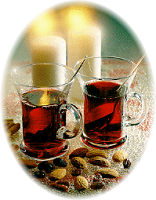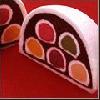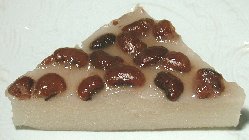::::::::::::::::::::::::::::::::::::::::::::::::::::::::::::::::::::::::::::::::::::::::::::::::::::
Bean curd (tofu, toofu, dofu)
***** Location: Japan
***** Season: Topic
***** Category: Humanity
*****************************
Explanation
Some tofu dishes come as kigo.
WASHOKU ... SEASONAL DISHES SAIJIKI

As a goroawase pun with numbers, since 1992, October 2 is
too fu no hi 十二の日 / 豆腐の日 day of tofu

Every month on the 12th 十二 is also day of tofu. 毎月12日
A pun with the pronounciation TO (10) and FU 2.
:::::::::::::::::::::::::::::::::::::::::::::::::::::::::::::::::::::::::::::::::::::::::::::::::::
Tofu, also Tōfu (豆腐) (the Japanese Romaji spelling toofu), doufu (the Chinese Pinyin spelling often used in Chinese recipes) or bean curd (the literal translation), is a food of Chinese origin, made by coagulating soy milk, and then pressing the resulting curds into blocks. There are many different varieties of tofu, including fresh tofu and tofu that has been processed in some way. Tofu has very little flavor or smell on its own, so it can be used either in savory or sweet dishes, and is often seasoned or marinated to suit the dish.
The production of tofu from soy milk is similar to the production of cheese from milk, although some tofu is made by processing non-soy products, such as almonds or black beans. The byproduct of the process is soy pulp (also called okara in Japanese).
Tofu originated in ancient China, but little else is known about the origins of tofu and its method of production. Tofu and its production technique were subsequently introduced into Korea, then Japan during the Nara period (late eighth century). It also spread into other parts of East Asia as well. This spread likely coincided with the spread of Buddhism as it is an important source of proteins in the religion's vegetarian diet.
© More in the WIKIPEDIA !
. Food vendors in Edo .
toofuya とうふ屋 / 豆腐屋 tofu makers and vendors
- see also below the haiku by Issa - tôfu ya
Some shops made only Tofu and the customers came to their shop to buy.
Others employed vendors (salesmen) to walk the streets.

toofu uri 豆腐売り vendor of Tofu
They walked the streets three times a day, to bring Tofu for breakfast, lunch and dinner. This was necessary in a time without refrigerator.
豆腐屋は時計のように廻る也
toofuya wa tokei no yoo ni mawaru nari
the Tofu seller
works all day round
like a clock
:::::::::::::::::::::::::::::::::::::::::::::::::::::::::::::::::::::::::::::::::::::::::::::::::::::
abura-age, abura age, aburaage あぶら(あ)げ (油揚げ)
thin slices of deep-fried bean curd
Inari Sushi (inarizushi いなり寿司)
In Northern Japan it is often 4 cm thick and called
aburage あぶらげ - 油揚げ
It was a special treet for festival days and then a deal was made. People would drink a sip of sake together and eat one large aburage with some soy sauce and spices.
janbpoo aburage ジャンボあぶらげ extra large abura-age
atsu age, atsuage, atsu-age 厚揚げ thick slices, about 2 cm thick
They can be cut into triangles.
. . . CLICK here for Photos !
agedashidoofu, agedashi tofu 揚げだし豆腐 grilled tofu in broth
. . . CLICK here for Photos !
frittierter Tōfu in leicht gewürzter Soße
annin doofu (杏仁豆腐) Annin almond tofu
a sweet desert preparation, Chinese origin. Often with fruit.
. . . CLICK here for Photos !
awayukidoofu, awayuki toofu 泡雪豆腐 . あわゆき豆腐 tofu with beaten eggwhite
Homemade Curd Dumplings
Okazaki Sweetcake, speciality of Ozaki, Mikawa (Nagoya)
ganmodoki がんもどき (雁擬き), ganmo
deep-fried bean curd containing bits of various kinds of vegetables.
tofu-fritters. also called hiryoozu ひりょうず。
Eaten sipped in soy sauce and grated ginger, or put in the oden hodgepodge.
. . . CLICK here for Photos !
::::::::::::::::::::::::::::::::::::::::::::::::::::::::::::::::::::::::::::::::::::::::::::::::::::
Giondoofu 祇園豆腐 Gion Tofu
- quote -
During the Edo period, the most famous food of Kyoto was Gion Tofu. Gion Tofu is a skewered roasted tofu. And serve with Shiro Miso paste (White sweet Miso paste) to dip the roasted Tofu. Originally had another name but the place was around Yasaka shrine (near Gion area), tourist called as Gion Tofu.
- source : kyojapan.com/gourmet -

CLICK for more ukiyo-e about Tofu !
::::::::::::::::::::::::::::::::::::::::::::::::::::::::::::::::::::::::::::::::::::::::::::::::::::
haiboshi doofu, shimeokabe 火干し豆腐, しめおかべ
tofu is warpped in a cloth and put into ashes over night to dry. Made in a temple in Kyoto 小金井の三光院
hiyayakko, hiya yakko 冷奴 "cold guy", "kalter Bursche"
square pieces of cold tofu, eaten with soy sauce and leek circles in summer
yakko was the name of the lowest social position in the Edo society, the simple workers of a daimyo household. They were the chuugen 中間(ちゅうげん)」 or orisuke 折助(おりすけ. yakko, most probably derived from the "child of the house", member of the household, ie no ko 家つ子 iekko. They came from poor farming families and did hard labour, carrying the luggage of the lord during traveling. They used to wear simple square jackets (hanten) with a square as decoration, kuginuki mon 釘抜紋.
. . . CLICK here for 釘抜紋 Photos !
So food that was cut in a square like this was called "yakko ni kiru" 奴に切る.
. . . Yakko Daruma Dolls
iburidoofu いぶり豆腐 smoked tofu 燻り豆腐
toofu no kunsei 豆腐の燻製 smoked tofu
from Gifu and other prefectures
iridoofu いりどうふ【煎り豆腐/炒り豆腐】 tofu crushed by hand, then roasted. Small cut vegetables can be added, like carrots, kikurage, shiitake mushrooms.
. . . CLICK here for Photos !
. ishidoofu 石豆腐 "stone tofu"
from the Iya valley, Tokushima. 祖谷豆腐 Iya Tofu
kinugoshi きぬごし(絹漉し) "silken strained tofu"
smooth fine-grained tofu
. . . CLICK here for Photos !
durch ein Seidensieb passierter Tofu
momen doofu 木綿豆腐 "cotton" tofu
firm and rather rough consistency
. . . CLICK here for Photos !
"Baumwoll-Tofu", harter Tofu
okara おから オカラ Okara
Rückstände bei der Tofu-Produktion
okara doonatsu オカラどーなっつ / オカラドーナツ
from Aichi prefecture.
. . . CLICK here for Photos !
rokujoo doofu 六浄豆腐 salted tofu shavingsWater is reduced by using sea salt, then dried and shaved. Shavings are kept in vinegar. Monks from Dewa brought this to Kyoto. Still produced in Yamagata.
. . . CLICK here for Photos !
Saga 佐賀県 tofu dishes from Saga prefecture
... godoofu ごどうふ tofu made with kuzu vines
... ishiwaridoofu 石割豆腐 "tofu that can split a stone"
... zarudoofu ザル豆腐 / ざる豆腐 tofu in a bamboo basket
... Ureshino Onsen Tofu 嬉野温泉豆腐 tofu with hot spring water
Saga doofu 嵯峨豆腐 from Kyoto, Arashiyama
shimi-doofu 凍み豆腐 / 凍り豆腐 frozen tofu
Gefriergetrockneter Tôfu.
Wird auch als kôri-dôfu oder kôya-dôfu Kooya Doofu 高野豆腐 bezeichnet.
Koya San in Wakayama 高野山
. . . CLICK here for Koya Dofu Photos !
Tochio-age 栃尾あげ fried tofu from Tochio
Niigata prefecture.
. . . CLICK here for Photos !
toofu chikuwa 豆腐竹輪 / 豆腐ちくわ Tofu Chikuwa
Tofu and ground fish meat is mixed and grilled.
Produced in Tottori.
. . . CLICK here for Photos !
toofu pan, toofupan 豆腐パン bread with tofu, Tofu-Bread
otoofupan, o toofu pan お豆腐パン
Either in the form of a bread of buns with tofu inside or tofu in the dough.
. . . CLICK here for Photos !
Reference
toofu shinjo 豆腐しんじょ Tofu balls with vegetables
Pounded tofu with hijiki seaweed or spinach leaves, wrapped in deep fried tofu
. . . CLICK here for Photos !
Tofu-Ball mit Gemüse und hijiki-Algen
toofu suiitsu 豆腐スィーツ sweets with Tofu
In Kurashiki a kind of handmade tofu ball is served with fruit and whipped cream.
..... 黒豆玉豆腐スィーツ
.................................................................................
toofugushi 豆腐串 skewer with tofu pieces
a kind of tofu dengaku with miso paste
. . . CLICK here for Photos !
Dengaku 田楽 dance and food Tofu Dengaku
.................................................................................
toofu kamaboko 豆腐蒲鉾 /豆腐かまぼこTofu is broken into small pieces and dried, some flavorings added and then rolled in a sudare to be simmered. Made in Akita.
. . . CLICK here for Photos !
toofukan 豆腐羹 toofu broth
Water is all pressed out to make it firm. Then simmered long time in soy sauce with low heat. Tasts like cheese. Made in Kyoto.
. . . CLICK here for Photos !
toofuyoo 豆腐よう Tofu with awamori liquorfrom Okinawa.
Tofu is mixed with awamori rice liquor and rice kooji to ferment.
Tasts good with beer.
. . . CLICK here for Photos !
toonyuu 豆乳 Tonyu, soy milk, soymilk
. . . . . toonyuu doonatsu 豆乳ドーナツ doughnuts with soymilk
. . . CLICK here for Photos !
tsuto doofu つと豆腐 tofu squeezed in bamboo matsTofu is wrapped in a bamboo mat 竹づと and squeezed. Then heated. Keeps long, can be used for boild dishes.
From Fukushima prefecture.
In Ibaraki, 藁づと is used or 菰で包み(こも豆腐 komo doofu).
. . . CLICK here for Photos !
. unohana, u no hana 卯の花 scrambled tofu dregs .
like deutzia blossoms
yakidoofu やきどうふ (焼き豆腐) grilled tofu
yakidofu, yaki toofu, yaki tofu 焼き豆腐 momen firm tofu which is slightly browned on both sides by broiling.
For the New Year, nishime, ni-shime 煮しめ is prepared, a yakidofu piece cooked in sweatened soy sauce together with other ingredinets.
. . . CLICK here for Photos !
. . . CLICK here for NI-SHIME Photos !
gebratener oder gegrillter Tofu.
Yuba 湯葉/湯波/油皮
Fresh or dried layers of the skin of soybean milk.
Speciality of Kyoto and Nikko. Often used in the vegetarian quisine of the monks.
. . . CLICK here for Photos !
Haut auf der erhitzten Soyabohnenmilch
*****************************
Worldwide use
Soyabohnenquark
*****************************
Things found on the way
hari kuyoo 針供養
memorial service for used pins and needles
Performed at some temples during wintertime. On this day, the seamstresses take a holiday and bring their old needles to the temple to stick them in a piece of tofu.
. . . CLICK here for Photos !
In times of old, fishermen used this day to appease the Sea Gods by sinking broken fishhooks onto the ocean bed. The tradition is now a refined ceremony practiced by housewives, clothmakers and even fashion students, who take a day off work to show their gratitude. They do this by placing their old needles and pins into a Japanese sambo navel orange, while their broken counterparts are stuck into some tofu or konnyaku jelly - a somewhat bizarre, though well-respected, memorial service for little bits of metal.
source : guides.hotelbook.com
. Hari kuyo 針供養 KIGO
Toofu saijiki 豆腐歳時記 Tofu during the seasons
- reference source : lionandmole.hatenablog.com -
*****************************
HAIKU
Matsuo Basho and Tofu
影待ちや菊の香のする豆腐串
kagemachi ya kiku no ka no suru toofugushi
waiting for sunrise ...
the tofu skewer smells
of chrysanthemums
or
celebrating till sunrise ...
the tofu stick smells
of chrysanthemums
Tr. Gabi Greve
It seems more natural to inverse the Japanese, which has the tofu skewers as the last line.
Written in the ninth month of 1693, Genroku 6, 元禄6年9月
At the home of Taisui 岱水.
 kagemachi 影待, lit. "waiting for shadows", refers to a custom of the Edo period to invite guests on an auspicious day of January, May or September for a good meal to stay awake all night and wait for the sunrise. In September, you could sit in a chrysanthemum garden and enjoy the flower exhibitions.
kagemachi 影待, lit. "waiting for shadows", refers to a custom of the Edo period to invite guests on an auspicious day of January, May or September for a good meal to stay awake all night and wait for the sunrise. In September, you could sit in a chrysanthemum garden and enjoy the flower exhibitions.Also called himachi 日待ち, waiting for the sun.
sunrise party
the mum's scent skewered
by the tofu kabob
Matsuo Basho, September of the year Genroku 6
Tr. Reichhold
Reichhold's comment:
On certain days in January, May, and September, it was customary to invite friends and customers to all-night parties of eating and drinking together in order to worship the sunrise. White squares of tofu were skewered on green slivers of bamboo, brushed with miso, and heated over open fires. The smoky flavor was similar to the fragrance of chrysanthemums.
- - - - -

source : tohudokoroogawa
色づくや豆腐に落ちて薄紅葉
irozuku ya toofu ni ochite usumomiji
they are starting to change color ...
a slightly red maple leaf
falls on my tofu
Written in 延宝5年, Basho age 34.
The whiteness of the Tofu is stressed by the color of the fallen leaf.
MORE - - -food haiku by
. Matsuo Basho 松尾芭蕉 - Archives of the WKD .
:::::::::::::::::::::::::::::::::::::::::::::::::::::::::::::::::::::::::::::::::::::::::::::::::::::
. Kobayashi Issa 小林一茶 in Edo .
Tofu-Haiku by Kobayashi Issa
楢の葉の朝からちるや豆腐桶
nara no ha no asa kara chiru ya tôfu oke
an oak leaf this morning
fallen
in the tofu tub

とうふ屋が来る昼顔が咲にけり
tôfu ya ga kuru hirugao ga saki ni keri (toofuya)
the tofu vendor comes--
the day flower
blooms
Shinji Ogawa notes humor in this haiku. He writes, "The phrase, 'tofu vendor coming,' should modify the day flower.
The haiku means: the day flowers of the tofu vendor's coming have bloomed. In Edo, those vendors came around like clockwork. People could tell, so it is said, the time of day, by the vendors. The day flower, as the name suggests, blooms at a specific time of day. Issa humorously applied this saying to create a comical haiku."
とうふ屋と酒屋の間を冬篭
tôfu ya to sakaya no ai wo fuyugomori
between tofu shop
and the tavern...
my winter seclusion
Tr. David Lanoue - MORE TOFU HAIKU by ISSA
.............................................................................
- - - - - Tr. and Comments by Chris Drake:
おそ起や蚊屋から呼るとうふ売
oso oki ya kaya kara yobaru toofu uri
sleeping late --
the tofu seller calls to me
from my mosquito net
This hokku was written in the 6th month (July) of 1818, when Issa was living back in his hometown. Issa and the tofu seller must know each other well, so the tofu seller must have been surprised when Issa didn't come out to buy some fresh tofu when he went by loudly singing out the short phrase or song he sings each morning as he walks through Issa's hometown with containers of tofu hanging from each end of a pole over his shoulder. Curious or perhaps concerned, the seller has apparently come inside Issa's house and into his sleeping room, where he now stands beside the large mosquito net, calling out to Issa in his normally loud voice. This time Issa definitely wakes up!
It was common for villagers to go inside each other's houses, probably saying a brief "Excuse me!" as they went in, and Issa's wife has presumably opened the door earlier, when she got up, though she must be out when the tofu seller goes by. This custom is still alive in many parts of rural Japan and partially alive even in the rural town outside Tokyo in which I live.
My neighbors often come inside the front door and call out something, and the man who comes around selling kerosene for space heaters comes inside and calls out to me if I don't go inside when he drives by. Sometimes I forget and lock the front door during the daytime, and my neighbors then ask me if I'm being unfriendly, though they try to understand, since I'm a foreigner.
:::::::::::::::::::::::::::::::::::::::::::::::::::::::::::::::::::::::::::::::::::::::::::::::::::::
春惜む宿や日本の豆腐汁
haru oshimu yado ya Nihon no toofujiru
lamenting spring
in this lodgings ... the tofu soup
of Japan
Masaoka Shiki正岡子規
He wrote this for his uncle Kato Shuson, who stayed in Belgium in the year Meiji 35. They remember the delicious leek miso-soup of Negishi.
::::::::::::::::::::::::::::::::::::::::::::::::::::::::::::::::::::::::::::::::::::::::::::::::::::
 The haiku poet Kita Masao 喜多牧夫 started off as a tofu maker and wrote many haiku about the subject, collected in the book
The haiku poet Kita Masao 喜多牧夫 started off as a tofu maker and wrote many haiku about the subject, collected in the booktoofubue 豆腐笛 flute of the tofu vendor
The four seasons and the people of Obuse.
信州小布施の四季と人
He was born in 1909 in Obuse, Niigata, where his family lost a fortune when the silk prices dropped.
He died in 1993, May 12, at age 83.
. . . CLICK here for Photos !
:::::::::::::::::::::::::::::::::::::::::::::::::::::::::::::::::::::::::::::::::::::::::::::::::::::

Claudia Cadwell, Facebook, June 2009
Thanks, Claudia!
*****************************
Related words
***** . WASHOKU - Favorite Tofu Dishes of Edo .
***** WASHOKU : INGREDIENTS
:::::::::::::::::::::::::::::::::::::::::::::::::::::::::::::::::::::::::::::::::::::::::::::::::::::::::::::::::::::::::::
. Toofuu Jizoo 豆腐地蔵 Tofu Jizo Legends .
. Tōfu kozō 豆腐小僧 Tofu Kozo, The Tofu Boy .
Tôfukai 豆腐買いTôfu Buyer
- - - - - Legends with tofu 豆腐伝説 - - - - -
:::::::::::::::::::::::::::::::::::::::::::::::::::::::::::::::::::::::::::::::::::::::::::::::::::::::::::::::::::::::::::
[ . BACK to DARUMA MUSEUM TOP . ]
[ . BACK to WORLDKIGO . TOP . ]
- #toofu #tofu #beancurd -
:::::::::::::::::::::::::::::::::::::::::::::::::::::::::::::::::::::::::::::::::::::::::::::::::::::::::::::::::::::::::::




































